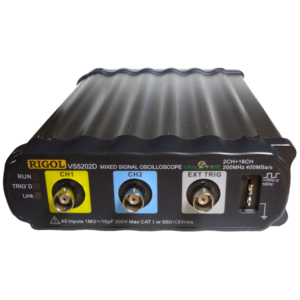Difference between revisions of "Rigol VS5202D"
Jump to navigation
Jump to search
Uwe Hermann (talk | contribs) m (→Photos) |
|||
| (11 intermediate revisions by 5 users not shown) | |||
| Line 1: | Line 1: | ||
[[File:Rigol_VS5202D.png|thumb|right|Rigol | [[File:Rigol_VS5202D.png|thumb|right|Rigol VS5202D]] | ||
The [http://rigol.com/ Rigol VS5202D] is a 2 channel analog and 16 channel digital, 200 MHz, USB-based oscilloscope/logic analyzer | The [http://rigol.com/ Rigol VS5202D] is a discontinued 2 channel analog and 16 channel digital, 200 MHz, USB- and Ethernet-based oscilloscope/logic analyzer. | ||
See [[Rigol VS5202D/Info]] for some more details (such as '''lsusb -vvv''' output) on the device. | See [[Rigol VS5202D/Info]] for some more details (such as '''lsusb -vvv''' output) on the device. | ||
See [[Rigol VS5000 series]] for information common to all devices in this series. | |||
== Photos == | == Photos == | ||
| Line 54: | Line 28: | ||
File:Rigol VS5202D PCB detail 4.jpg | File:Rigol VS5202D PCB detail 4.jpg | ||
File:Rigol VS5202D PCB detail 5.jpg | File:Rigol VS5202D PCB detail 5.jpg | ||
File:Rigol VS5202D | File:Rigol VS5202D accessories.jpg | ||
File:Rigol VS5202D digital pod.jpg | |||
File:Rigol VS5202D digital pod connectors.jpg | |||
</gallery> | </gallery> | ||
[[Category:Device]] | [[Category:Device]] | ||
Latest revision as of 22:59, 16 August 2017
The Rigol VS5202D is a discontinued 2 channel analog and 16 channel digital, 200 MHz, USB- and Ethernet-based oscilloscope/logic analyzer.
See Rigol VS5202D/Info for some more details (such as lsusb -vvv output) on the device.
See Rigol VS5000 series for information common to all devices in this series.





















